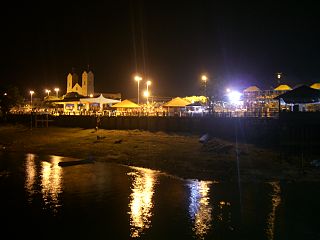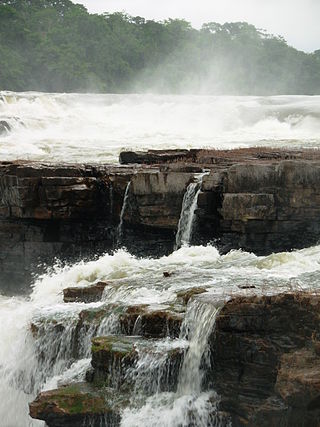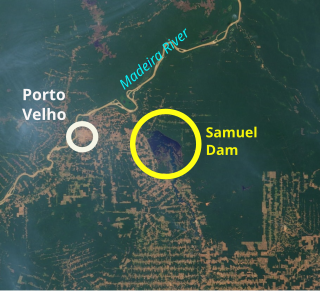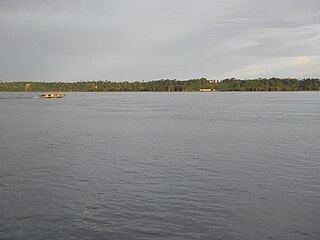
Terra indígena Raposa/Serra do Sol is an indigenous territory in Brazil, intended to be home to the Macuxi people. It is located in the northern half of the Brazilian state of Roraima and is the largest in that country and one of the world's largest, with an area of 1,743,089 hectares and a perimeter of about 1,000 kilometres (620 mi).

Itaituba is a city and municipality located in the state of Pará, Brazil, and one of the most important socioeconomic centers in the western region of the State.

Uiramutã is a municipality located in the northeast of the state of Roraima in Brazil. Its population is 10,789 and its area is 8,066 km2. It is the northernmost municipality of Brazil, with Monte Caburaí being the northernmost point. West of this mountain, there is also the Monte Roraima, the tallest mountain in Roraima and in Guyana, located in the triple frontier of Brazil, Guyana and Venezuela. Still, Uiramutã holds the title of the northernmost urban seat of a municipality in Brazil. Its counterparts in the South, West and East are respectively Chuí, state of Rio Grande do Sul; Mâncio Lima, Acre; and João Pessoa, Paraíba.

The Balbina Dam is a hydroelectric dam and power station on the Uatumã River in the Amazon Rainforest, Brazil. The location is under the municipality of Presidente Figueiredo jurisdiction, in the state of Amazonas.

The Jamanxim River is a river of Pará state in north-central Brazil. Originating in the Serra do Cachimbo, it is a tributary of the Tapajós, into which it flows a few kilometers upstream from Itaituba.
The Panari River is a river of Roraima state in northern Brazil. It is a tributary of the Cotingo River.

The Xingó Dam is a concrete face rock-fill dam on the São Francisco River on the border of Alagoas and Sergipe, near Piranhas, Brazil. The dam was built for navigation, water supply and hydroelectric power generation as it supports a 3,162 megawatts (4,240,000 hp) power station. It was constructed between 1987 and 1994 and the last of its generators was commissioned in 1997. In Portuguese, the dam is called the Usina Hidrelétrica de Xingó.

Juruena National Park, declared in 2006, is the third largest national park of Brazil. It is located along the Juruena River, in the north of Mato Grosso state and the south of Amazonas state. It forms part of a corridor of protected areas that is meant to contain agricultural expansion into the Amazon rainforest.

The Samuel Hydroelectric Dam is a 216 MW hydroelectric dam near Porto Velho, Rondônia, Brazil. The project was controversial since it had a major environmental impact and during operations released more greenhouse gases than a comparable oil-fuelled plant.

Mapinguari National Park is a national park in the states of Rondônia and Amazonas, Brazil. It covers a large area of Amazon rainforest. The boundaries have been adjusted several times.

Mount Roraima National Park is a national park in the state of Roraima, northern Brazil.
The Lago de Santa Isabel Environmental Protection Area is an environmental protection area in the state of Tocantins, Brazil. It was created to protect the shores of the reservoir of a planned hydroelectric dam, which has not been given an environmental license. Vegetation is in the Amazon biome.

The Jatobá Hydroelectric Power Plant is a planned hydroelectric power plant and dam on the Tapajós river in the state of Pará, Brazil. As of 2017 the project was suspended.
The Chacorão Dam is a proposed dam on the Tapajós river in the state of Pará, Brazil. It would flood a section of rapids in the river, making them navigable by barges carrying soybeans to ports on the Amazon River. The dam would include locks for the barges and a hydroelectric power plant. It is controversial since it would flood a large area of an indigenous territory.

The Mundurucu Indigenous Territory is an indigenous territory in the state of Pará, Brazil. It is occupied by the Apiacá and Munduruku people. A proposed dam on the Tapajós river is on hold since it would flood part of the territory, and the constitution does not allow projects that would force relocation of indigenous people.
The Cachoeira do Cai Dam is a planned hydroelectric dam on the Jamanxim River in the state of Pará, Brazil, with a capacity of 802 megawatts (1,075,000 hp).
The Cachoeira dos Patos Dam is a proposed hydroelectric dam on the Jamanxim River in the state of Pará, Brazil. Work has been delayed due to concern about environmental impact and lack of consultation with affected indigenous people.
The Jardim do Ouro Dam is a proposed hydroelectric dam on the Jamanxim River in the state of Pará, Brazil. The dam would have a 42,600 hectares reservoir and capacity of 227 megawatts (304,000 hp). It has not been studied on detail due to relatively low return on investment compared to other projects in the region.
The Jamanxim Dam is a proposed hydroelectric dam on the Jamanxim River in the state of Pará, Brazil.

The Tapajós hydroelectric complex is a proposed complex of hydroelectric dams on the Tapajós and Jamanxim rivers in the state of Pará, Brazil. The Tapajós dams would contain locks, thus converting the river into a navigable waterway. A "platform" model is proposed under which all people and material would be moved by river or by helicopter, avoiding the need to build access roads and the consequent inflow of settlers and environmental damage. However, there have been protests against flooding of indigenous territory by the dams, and the largest dam seems unlikely to be approved.














